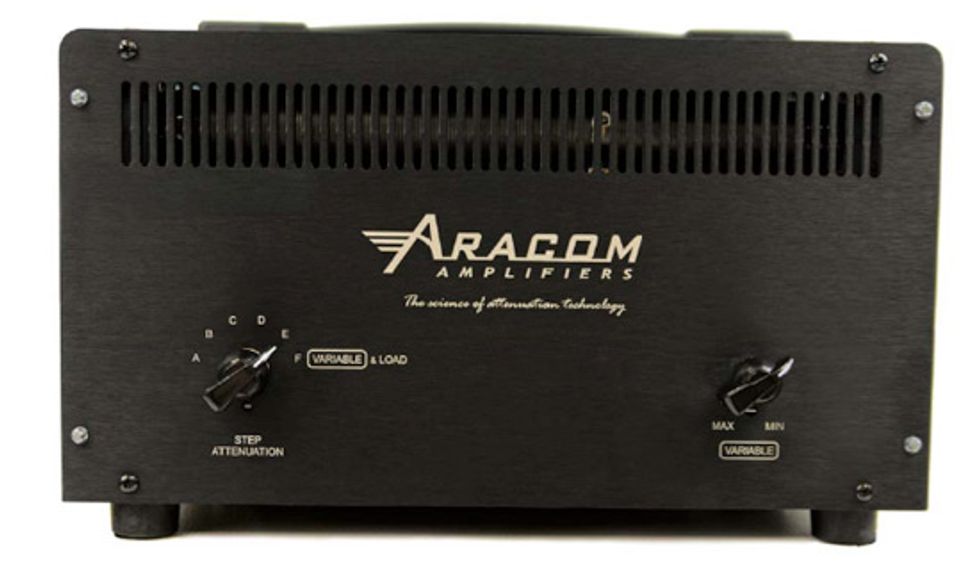If you have an amp that sounds great when
you crank it up but it’s just too loud for most
playing situations, you’ll want to know about
the new Aracom Power Rox PRX 150-Pro
amp attenuator. Designed for use with tube
amps, this unit lets you reduce the level of a
fully cranked head or combo.

The PRX 150-Pro is housed in a black anodized-aluminum case with an amp-style strap handle, and it looks all business. When I unpacked my review unit, the vented front, side, and rear panels caught my eye. They are, of course, for cooling, but they give the box a striking, industrial vibe. A passive device, the PRX 150-Pro requires no AC power for operation.
Two front panel knobs—Step Attenuation and Variable—let you control your amp’s output level. Step Attenuation has six discrete settings labeled A-F. Settings A-E reduce the level in 3 dB increments. Switching to position F engages the Variable knob, which lets you further attenuate the output by as much as 16 dB. The unit can handle a 150-watt input signal and our review model provided an overall cut of 30 dB (which effectively takes a 100-watt amp down to 0.5 watts—3% of the amp’s power rating). However, Aracom informs us that the latest PRX 150-Pros can attenuate up to 40 dB— which can take a 150-watt amp down to .015 of a watt.
The PRX 150-Pro’s magic really happens at the back panel. The input—where you plug in your amp’s speaker output—offers 2-, 4-, 8,- and 16-ohm settings, and that’s what sets the PRX apart from most other attenuation devices. Having a variable input selector lets you use the PRX with different amps with various fixed output impedances. You don’t have to purchase separate units to accommodate, say, a Fender Super Reverb and a Marshall JCM900. And if your amp offers selectable output impedance, you can explore the different taps on the output section, which can alter the amp’s tone and feel.
The Aracom’s own output impedance is also variable, and you can set this independently of the unit’s input impedance. You can switch the PRX 150-Pro’s parallel output jacks to 2, 4, 6, 8, and 16 ohms, which gives you complete flexibility to mix and match amps and speaker cabs with dissimilar impedance ratings. Very flexible. Further, a true-bypass switch on the back panel allows you to bring the PRX in and out of the circuit.
How Does It Sound?
I tried this unit with several types of amps, using both Les Pauls and Strats, to get a good idea of the unit’s sonic capabilities. First, I used a 4-ohm Fender head with a 16-ohm Marshall cabinet. When I used this type of rig in the past, I had to rewire my Marshall cabinet to 4 ohms. I was pleasantly surprised to hear this setup with both amp and cabinet operating at their normal impedances. The sound on the least attenuated setting (A) was more open and a bit tighter in the low end than I was used to hearing.
As I reduced the levels by stepping through settings B-E, I detected little sonic difference until I got down to the Variable knob settings. It’s worth noting that when you lower the dB level on a high-powered amp—whether with a master volume or a power attenuator— the sound changes because you’re not pushing the speakers as hard. This is simply a mechanical issue. That said, the feel I got using the PRX 150-Pro at these lowered levels was great. And this made playing quietly a lot more enjoyable.
I tried other amp combinations, including a Marshall Super Lead head with a Marshall cabinet and a Vox AC50 with a 2x12 Vox cabinet. I had the Vox set to 8 ohms to match the cabinet’s 8-ohm impedance. With each rig, the results were very much the same: Tone and feel stayed consistent through the A-E ranges. Testing the Marshall head was especially fun, because I tried switching between transformer taps, which altered the amp’s tightness, overtones, and low-end response. In this application, the Aracom gives you another option for sculpting your tone. (By the way, the 8-ohm tap on the Marshall sounded best to me.)
The Final Mojo
Sonically, the Aracom PRX 150-Pro attenuator stayed very true to every amp I paired it with. My tone stayed stable as I lowered the dB level to its minimum amount (the variable control doesn’t turn the sound completely off). Even super-quiet bedroom settings sounded very good and responded to picking and touch extremely well. This attractive, sturdily built unit would be a great addition to any guitarist’s tone arsenal.
Buy if...
you need quality tones at lower levels, or you need to match impedance between different amps and cabs.
Skip if...
you have a low-power amp that already provides the tone and volume levels you require.
Rating...
Street $660 - Aracom Amplifiers - aracom-amps.com |






![Rig Rundown: Russian Circles’ Mike Sullivan [2025]](https://www.premierguitar.com/media-library/youtube.jpg?id=62303631&width=1245&height=700&quality=70&coordinates=0%2C0%2C0%2C0)

















